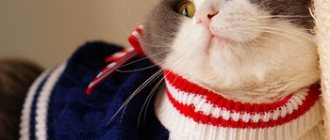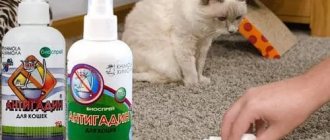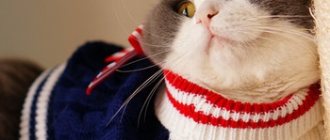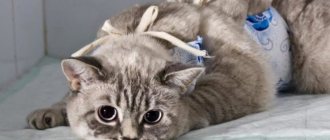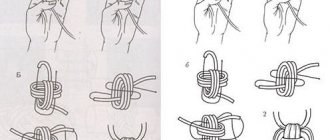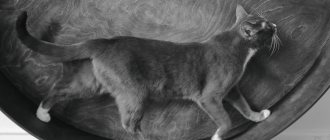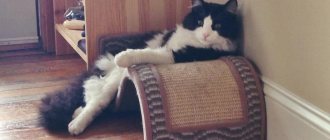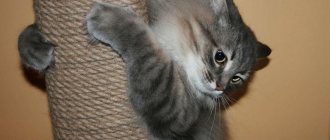Unlike most other cat breeds, Sphynx cats are not endowed with thick hair: they have a little hair on the tail, paws, and in the bridge of the nose. Therefore, it is more difficult for such pets to stay warm in the cold season, and they will definitely not give up their clothes.
Things can be made with your own hands from yarn, natural fabrics or various scrap materials (even from woolen socks). This way the owner will be able to warm the cat or take him for a walk in cool weather.
There are models of stylish dresses, suits and sweaters for adult cats and kittens that are easy to create if you follow the step-by-step instructions.
DIY clothes for the sphinx - we knit and sew using a universal pattern, photos and videos
By nature, cats are endowed with a luxurious and warm fur coat, but there are times when it is necessary to insulate the animal, for example, during transportation. Or a breed of cat, such as the Sphynx, does not have a warm coat, so it needs additional heating. They need to dress not only when going outside, but also while in a cool room. The selection in pet stores exceeds all expectations, but the clothes made for the Sphynx will be unique and will be ideal for your own pet, because you will make it with your own hands.
A cat's wardrobe can consist of both knitted items and those made from ready-made fabric.
Airy skirt
Clothes for cats are needed not only to keep your pet warm, but also for going out into the world. Thus, show animals often appear before judges in exclusive outfits. Skirts are especially relevant in cat fashion, giving femininity and charm to sophisticated breeds.
To create such an unusual accessory you will need:
- tulle;
- satin ribbon;
- scissors.
The easiest way to create a fluffy ballet tutu does not require any drawings or patterns. To sew a skirt, just measure the cat’s “waist” circumference and add 10 cm to this value.
Required materials and work process
The satin ribbon is cut to the obtained length. The tulle is cut into strips 2 cm wide. The length of the strips is equal to the required length of the skirt multiplied by 2.
Next, the tulle strips are folded in half and tied onto a satin ribbon with loose knots, as shown in the photo. The thicker the ribbons are tied, the more magnificent the pack will be. To add volume to the product, the length of the strips can be varied. To create color transitions, tulle of various shades is used.
How to cut and attach ribbons
When all the stripes are tied on a ribbon, the skirt is tried on the cat. The free ends of the tape are tied on the back of the animal and their length is adjusted.
Ready-made skirt
We knit clothes for the sphinx with our own hands in a step-by-step tutorial
When choosing yarn, we monitor the composition of the threads; they should consist of natural substances and should not be electrified. Before work, measure the circumference of the cat’s neck and the approximate length of the product.
Necessary materials:
- Wool threads or half with acrylic 100 grams
- Knitting needles No. 3.5
- Circular knitting needles No. 3.5
- Needle for stitching
When knitting, follow the sample shown in the photo below, substituting your measurements if necessary. Keep in mind that the product should not be too tight and restrict movement, and should not sag, preventing its owner from moving.
Knitting density 16 loops x 20 rows in 10 x 10 cm
We start the process in front of the neck and follow the pattern; if the knitting density is different, adjust the number of loops to maintain the dimensions.
- We cast on 25 stitches on the knitting needles and knit 3 cm with a 1x1 elastic band (1k.x1p.).
- We continue to knit in stockinette stitch for 10 cm.
- On both sides, 13 cm from the edge, we cast on 18 stitches and knit 61 stitches for another 10 cm.
- For the cutout, close off 21 sts in the middle, and in the next row cast on 28 sts instead.
- Another 10 cm in stockinette stitch, and close off the outermost 18 stitches on both sides.
- The last 10 cm with the main pattern and again 3 cm with the same elastic band. We close the loops.
- Sew the side seams and sleeves.
- We cast on loops from the neckline on circular knitting needles and knit with a 2x2 elastic band (2 knits x 2 purls) the collar, if desired, is either short or with a turn-up, so that it is comfortable for the cat.
Here is the simplest option; of course, the main pattern can be changed at your discretion, you can combine the colors and shape of the product, in general, everything is in your hands.
The best "cat" materials
Sewing clothes for cats is also demanding in terms of the preparatory stage - choosing fabric for the outfit. In this case, be sure to take into account:
Based on these criteria, the main requirements for the fabric are determined: moisture resistance, fading in the sun, wear resistance, ease of washing or cleaning, absence of strong “odors,” and the ability to retain heat. The first, easiest option is to consult with a seller who can give practical advice.
If the housewife decides to do everything herself, then it is better to choose one of the following materials: viscose, linen, synthetics, cotton, wool, mixed fabrics. Combinations are possible. To save your pet from potential allergic reactions, many cat “parents” limit their range to only natural materials. The logic of this decision is difficult to dispute.
Let's move on to detailed tailoring for your beloved cat
To sew cat clothes we will use a universal pattern. It is suitable for a number of models: sweaters, overalls, dresses, etc.
If knitted items need a fastener, then when sewing you need to think about this detail. Lightning is contraindicated for ordinary cats, since the hairs get caught in a zigzag; in the case of the Sphynx, there is no such problem. But it will be more convenient to use velcro tape or buttons, and the latter will even serve as an excellent decoration. Velcro will allow you to quickly dress your pet. It is better to place the fasteners on the back so that they do not interfere with the cat.
A rustling material is not acceptable for use, as it will frighten the animal and will not want to wear this clothing.
Depending on the type of product, the sleeve may be shorter or completely absent.
You can also make holes in the hood for ears, it will be very cute.
Before cutting, be sure to try on the paper version and correct any inconsistencies so as not to spoil the fabric later.
Place the pattern on the laid out fabric with the wrong side up, carefully watch where the fold is needed, how many parts are required, trace it with chalk and cut it out.
We connect the side, shoulder, and sleeve seams, if any. We sew on a zipper or Velcro and begin processing the edges. The knitted fabric is twisted along the edge, it does not need to be edged, the rest is either folded and hemmed, or we use bias tape, this will look more aesthetically pleasing. Another interesting option is to crochet the edges of the neckline and sleeves.
Preparing the pattern and step-by-step production
You can make the main pattern and transfer it to the fabric. To do this, draw a trapezoid on paper or newspaper. It is worth rounding the edges and making holes for the paws. The following measurements will help with this: neck circumference, distance between the legs, back and chest length.
On the pattern you will need to add 1-2 cm to the seams and fastener.
The suit should not fit the animal tightly so as not to impede its movement.
If you want to create a complex version of the pattern, then you need to make it in two parts: the upper one for the back, the lower one for the chest.
Cute vest
How to make a vest for cats:
Overalls
To sew walking overalls, you need to use the base pattern and adjust the desired length. The overalls for a cat should be loose so as not to interfere with the pet’s movements on the street.
DIY clothes for the sphinx: diagrams with photos and videos
Not everyone can afford to buy a cat due to allergies, but if you have been dreaming of a pet for a long time, then a Sphynx could be one. This breed is not allergenic, so it will not harm anyone, but will only give positive emotions. However, such an animal needs special care - a special diet, because not everyone can eat such cats, and improper nutrition can lead to bad consequences. They also need clothing that can protect them from cold winds and drafts. To do this, you can go and buy special suits and overalls in specialized stores, but you can also sew everything yourself. Do-it-yourself clothes for the sphinx can be made from ordinary fabrics - no longer used sweaters, leggings, socks, dresses, sweaters, or knitted from yarn that is left over, or unravel an unnecessary sweater.
The main principles of sock sewing
Despite the very wide selection in stores, many owners prefer hand-made sewing, and there are a number of reasons for this.
First, you know what kind of fabric you are using. It is very important that it is natural to avoid allergies or irritation to the sensitive skin of the purr.
Secondly, sock cat clothes are quite simple. There are no elements in it that will hinder your pet’s movements or allow you to get confused in them. Do not forget that cats are playful and active animals, and tight clothing will not allow them to spend energy as they should.
Therefore, if you decide to make clothes for your cat with your own hands from a sock, you should make sure that the product meets the requirements described above, and you should not weigh it down with unnecessary accessories. In addition, be sure to check the elastic - it should not be too tight so as not to squeeze the animal’s neck. Having made sure that all points have been met, you can safely get to work.
Sweater for a cat
The Sphinx is an animal that has short hair, large ears like a bat, and is not always easy-going. But those who love this breed of cat know that they need to be kept warm at all times, because they are susceptible to cold. Therefore, it is necessary to insulate your pet if it is cold in the apartment or sometimes you take it out of the house. In this master class we will learn how to knit a cute sweater for your pet. For such a small product you will have to spend a little time, but then the cat or cat will be warm and will continue to delight the household for a long time.
Before we start knitting a sweater, we need to take measurements from the cat - length of the product, belly circumference, belly and back length, neck circumference.
Then we need to create patterns, which we can then use for further products for the cat. Knitting patterns are very simple, so even a novice needlewoman can handle it.
What we need to prepare:
- white wool mixture threads;
- red acrylic threads;
- knitting needles number 3;
- a needle with a large eye.
We start knitting from the collar. To do this, we put 71 buttonholes on the knitting needles with red threads and knit an elastic band, one front and one purl, to a height of seven centimeters. Now we divide the resulting fabric into two parts, where 25 buttonholes will be the stomach, and the remaining 46 will be the back. Now we switch to white threads and begin to knit with two balls, separately for the back and separately for the tummy.
1st row: belly - we knit all the buttonholes with knit stitches, while making 14 yarn overs evenly throughout the row. Back - we knit 23 buttonholes with knit stitches, then one yarn over and again with 23 knit stitches.
2nd row: we knit all the buttonholes purl on the back – that’s 47 stitches. Belly – 39 stitches are knitted with an elastic band one after another.
3rd row: tummy - remove the buttonhole, one yarn over, then again elastic 37 loops, and again yarn over and knit; back - remove, yarn over, knit 45, yarn over, knit. 4th row: back - purl everything; tummy - 41 buttonholes are knitted with an elastic band one after another. 5th row and 10th row: we knit the same way as the 3rd and 4th.
From the 11th row we begin to form armholes: tummy - close 3 buttonholes and knit 41 loops with an elastic band; back - close three buttonholes, purl the remaining 52 buttonholes. 12th row: back - close three buttonholes and purl the remaining 49; close three buttonholes, and then knit 41 loops with an elastic band. 13th row to 27th: we knit taking into account the pattern.
28th row: belly – you need to pick up three air stitches and then knit taking into account the pattern; back - three air and again taking into account the pattern.
How to sew clothes for a cat with your own hands
Almost all breeds of smooth-haired cats freeze in winter, especially if the home has low heating or is not very warm for some other reason. In this case, the owners have to dress their pet.
Also, many people choose outfits for an animal just for the sake of beauty, and some even prepare costumes for exhibitions and real fashion shows, where the main models are cats dressed in chic outfits.
If you dress your pet in specialized salons, it can cost a lot of money. It will be much more profitable to sew clothes for a cat with your own hands. This can be done relatively simply using these recommendations.
How to choose a costume for your pet in a store
Modern pet stores, veterinary clinics and private craftsmen offer a wide variety of clothing options for animals. The owner can choose a costume for the pet for all occasions and all seasons of the year.
Some owners like to buy their Sphynx unique outfits for each holiday. Typically, such a suit performs more of a decorative function rather than a warming or protective one.
Basic requirements for a cat outfit:
- Clothing should be selected according to the size of the animal. Things that are too large or small can cause discomfort to the sphinx, and will also not fully perform its main functions.
- There should be no hard elements in the suit. They hinder the animal's movement and can cause injury. The outfit should stretch a little to make the cat feel comfortable.
- Possibility of quick washing. Even with the most careful wearing, clothes get dirty with daily secretions, so one of the requirements is hygiene, so that the suit can be easily washed and dried within 1-2 hours.
- The collar of clothing should be loose, and you should also avoid laces and ribbons around the neck. During active play or running, a cat may accidentally get caught by these elements on some object, which is dangerous due to suffocation.
- All decorative elements must be firmly fixed to the fabric, and the threads should not stick out so that the animal cannot tear them off and swallow them. There are known cases of the development of intestinal obstruction in cats associated with the ingestion of small objects from clothing.
Photo gallery: examples of clothing for pets from the store
A suit with a hood will help protect your head from the cold. A hat, shirt and pants help create a complete look for this cat.
A cat in a princess costume will be seen at any exhibition
A sheep costume will bring a lot of pleasant emotions to you and your pet. In a fluffy costume, the sphinx looks extremely attractive
What material is best for the skin of hairless cats?
The skin of sphinxes is very sensitive: it is easily damaged or injured by hard fabric. It is also worth remembering that synthetic materials do not absorb secretions from the cat’s skin well, are practically not ventilated and, if worn for a long time, can cause irritation or a rash. What fabrics can be used to create clothes for the sphinx:
- chintz;
- wool (including yarn for knitting);
- batiste;
- flannel;
- bike;
- viscose;
- knitwear;
- tulle.
If you are planning to make a complex and multi-layered outfit for your pet, natural material can only be in the part that is in direct contact with the cat's body. For insulation and external finishing, you can use synthetic fabrics that have moisture and wind protection properties.
Veterinarians do not recommend buying low-quality or cheap fabrics for sewing cat clothes. One of my friends, who works as a doctor in a veterinary clinic, talked about several cases of sphinxes developing an allergy to the paint with which the costume material was coated. This was accompanied by the appearance of a small red rash, which the cats constantly scratched and licked, which only worsened the situation. The doctor recommended that housewives get rid of low-quality clothes and let the sphinx be without a suit for a while so that the rashes dry out and go away on their own. Within a few days, the pets began to feel well, after which they were given special outfits made of natural, breathable fabric.
How to decide on suit size
The size of clothes for the sphinx is selected individually based on body length measurements along the back and approximate body weight. Thus, there are 7 size groups according to which you can choose an outfit for any animal:
- XXS. Designed for very small kittens whose body length does not exceed 25 cm and weight less than 1.5 kg.
- XS size is worn by cats with a body length of 30–32 cm and a weight of 1.6 to 3 kg.
- S. Body length - 33–36 cm, weight from 3 to 4 kg.
- M. Length 37–40 cm, animal weight 4–4.9 kg.
- L. The length of the outfit is 41–43 cm, the weight of the cat is 5–5.9 kg.
- XL. The length of the suit along the back is 43–45 cm, weight up to 6.9 kg.
- XXL. Occurs in large cats suffering from obesity. The length is more than 45 cm, and the weight is more than 7 kg.
Types of clothes for cats that you can sew yourself
To start sewing clothes for cats, you don’t need to draw a pattern every time; it’s enough to do it once, and then make the necessary adjustments as necessary. This pattern is suitable for sewing many types of clothing. Using it, you can make a comfortable T-shirt so that the Sphynx or a cat of another smooth-haired or hairless breed does not overheat in the sun. For this, the best choice of material would be knitted fabric.
If you take a denser material and make a slightly smaller cut for the neck, as well as openings for the paws, you will get the option of a warm sweater, jacket, sweatshirt or blanket for winter walks on the street or living in poorly heated rooms.
By choosing elegant jewelry and an interesting color composition, you can create a dress or suit in which your pet will not be embarrassed to be shown at shows.
Carnival costumes for cats look very cute:
When creating a sketch and pattern, it is extremely important to think about the arrangement of the parts so that the cat can breathe and move freely without getting entangled in the abundance of decorations. You should not sew on any sharp or piercing decorations, as well as those elements that the animal can tear off and swallow.
How to take measurements of a cat
Before starting to sew clothes from a sock for a sphinx or other similar animal, some owners take measurements from it. This will make the sweater more comfortable. There are three main measurements:
Additionally, you can remove the volume of the paw if you want to add sleeves to the sweater. When taking measurements, it is very important that the animal is calm and standing on all fours. If you are not sure that you can handle it yourself, you should seek help from members of your household who will help calm the mustachioed one.
If the cat categorically refuses to have measurements taken, you should not torture the animal or cause it stress. It's easier to make a sweater using the standard pattern.
Taking the necessary measurements
The most important parameters for a cat costume pattern are the girth of the neck (measurement 1), the length of the animal’s back from neck to tail (measurement 2) and the size of its body in girth, which is measured in the area immediately behind the front paws (measurement 3).
Additionally, depending on the purpose of the clothing, the following data may be required to create a pattern: the distance from the front to hind legs; the volume of the cat's waist, which refers to the girth of the body in the area of the hind legs.
After receiving the necessary numbers, you can start creating a pattern. Later, the pattern made according to the received pattern must be attached to the pet and the necessary adjustments must be made, and the dimensions before this must be taken with a small margin, so as not to redo the work later.
Turtleneck
This pattern will help you knit a comfortable short-sleeve sweater for your cat. You can knit it sleeveless by simply tying the armhole. Before making a pattern, you must measure the cat and write down its dimensions. Using these dimensions, you will create an individual pattern, which will come in handy more than once in the future.
The depth of the armhole depends on the size of the cat. If you plan to edge the armholes with elastic, then increase their height and depth by 1 cm. You need to reduce the width of the backrest as follows:
- Smoothly: knit 2 loops together along the edges of the back in every second right row.
- Sharp: Knit 2 stitches together along the edges of the back on each RS row.
We knit with an elastic band (knit 1, purl 1). You can decorate the back with braids or braids. We knit the collar with an elastic band (k2, p2).
Pattern
1 is 1/3 of the neck circumference
2 is 2/3 of the neck circumference
3 is the distance from the base of the neck to the front paw
4 is the distance between the front paws
5 is the width of the back + 2 cm (allowance for armholes)
(chest circumference + 3 cm) = (distance between front legs + 2 cm)
6 is the length of the tummy = the distance from the base of the neck to the middle of the abdomen.
7 is the length of the back
8 is the height of the armhole, increased by 1 cm of the girth of the front paw - multiply the depth of the armhole by 2.
9- armhole depth = 1 – 3 cm.
We measure the cat, transfer it to paper, cut it out and knit it, looking at the pattern.
Pattern of clothes for a cat: a few simple ideas
- The simplest pattern for cat clothes is if you take as a basis a pant leg or sock of suitable sizes, mark holes for the paws on them with chalk, and then carefully cut them out using nail scissors.
This will save time on drawing up the pattern and will only require stitching the edges, sewing on the necessary fasteners, decorations and any useful accessories, for example, a loop for a leash.
- The second simple pattern of clothes for a cat in this photo:
To create such a pattern, you will need to measure the cat's neck circumference, back length, bottom circumference and distance between the legs. It is necessary to provide allowances for the fastener and correctly mark the holes for the paws.
Vest without pattern
To sew a vest for a cat, it is not necessary to draw complex patterns. All you need is an old sweater, scissors and some creative inspiration. The model in the picture shows a dog, but the proposed accessory is perfect for a cat of any breed.
Clothing suitable for both cats and miniature dogs
The step-by-step production of such a vest is presented below:
- the sleeve is cut off from a knitted sweater;
- draw a curved line with chalk next to the cut - on the stomach the vest should be shorter than on the back;
- cut off the excess along the marked line and overcast the edge. You can use either an overlocked hand stitch or an overlock stitch;
- The future vest is applied to the animal and the location of the holes for the paws is marked. The closer to the narrow edge the holes are made, the smaller the vest collar will be;
- Having folded the sleeve in half, reflect the marks for the holes symmetrically and cut them out. You can overcast the edge in any way.
After fitting, the craft is adjusted. If necessary, it can be sutured.
Video - Vest for walking
Fabric cutting, fitting and sewing
Before cutting, the fabric needs to be washed and ironed to make sure how much it shrinks. In this case, you should definitely take this into account when sewing and select a slightly larger size than the animal needs.
The layout of the blanks is carried out on the fabric folded in half from large elements to smaller ones so that the direction of the grain thread becomes parallel to the edge of the fold.
Then do the following:
- secure the paper template with pins to the fabric and carefully trace the design;
- then cut out all the necessary parts, not forgetting the seam allowances;
- sweep them away with a bright thread and put the resulting clothes on the cat;
- If there are any problems, apply the markings necessary to correct them with chalk.
Well-fitted clothing items can be finally put together. First, fasten the upper, located on the back, and the lower, running along the stomach, halves of the suit. The seams on the sides and in the shoulder girdle are sewn with a zigzag stitch with flat overlapping stitches. The width of the armhole must be selected depending on the purpose of the item of clothing, narrowing it for a winter version of the suit, and widening it for a summer T-shirt.
Then you need to process the edges of the clothing. To do this, you can use a braid with an elastic band. It is attached from the front side with the same zigzag stitches, stretching it a little before doing so, so that the braid does not gather and compress the edges too much. This will not only prevent the edges from fraying, but will also be a nice decoration for your cat costume.
The last stage is sewing fasteners and accessories to decorate the costume. There are a large number of fasteners that you can choose from for your cat suit. There are several recommendations in this regard, but first of all it is necessary to take into account the breed of the animal.
The zipper is best for smooth-haired pets, otherwise the hair will get stuck in the mechanism. In the same way, hairs will linger on Velcro. Universal fastenings are buttons that can be placed either on the back or under the chest of the animal.
After completing all these operations, you will make a luxurious costume for your pet.
Let's get started
To work we need:
- knitted or woolen fabric.
- scotch
- pins
- scissors
- Velcro, zipper or buttons
- bar of soap
- paper
We have a drawn or printed pattern for a cat's clothing. Once you have taken your cat's measurements, try to see if the pattern will fit you. If it doesn’t fit, it’s okay, you can always adjust the pattern on paper.
We bend sheet A-4 in half so that the breast is made in 2 copies. We place the back pattern on paper. Trace and cut out. We take tape and fasten the sides and shoulders together. We have a blank, measure it for a cat. If you don’t need to redo it, remove the tape and straighten the pattern. We attach the pattern pieces to the fabric, secure with pins, and outline with a piece of soap. We cut out the parts, not forgetting about seam allowances and space for Velcro or buttons. Remove the pins and set aside the pattern. We sew Velcro to the back using a machine or by hand. Sew the shoulder and side seams. Next we need to finish the neckline, bottom and armholes. If you have knitwear, it is better to trim it with stripes from the same knitwear. If finishing is needed, a braid with an elastic band works well. Sew to the neckline, hem and armholes. The vest is ready.
Let's sum it up
So, based on one pattern, you can make a large number of costumes and significantly update your cat’s wardrobe. For those who know how to sew, this will not be a problem and will not require serious financial expenses. Moreover, sewing costumes for a pet will be an excellent opportunity to realize your interesting ideas and turn into an excellent long-term hobby.
Sources:
https://sdelala-sama.ru/shityo/2874-odezhda-dlya-sfinksa-svoimi-rukami.html https://dekormyhome.ru/rukodelie/odejda-dlia-sfinksa-svoimi-rykami-shemy-s-foto -i-video.html https://www.samoshvejka.ru/news/kak_sshit_odezhdu_dlja_kota_svoimi_rukami/2017-03-19-352
